
(Reuters) – High numbers of Chinese students at Australian universities have created an environment of self-censorship with lecturers avoiding criticism of Beijing and Chinese students staying silent in fear of harassment, Human Rights Watch said.
Some parents in mainland China had been questioned by Chinese police about the activities of students in Australia and Hong Kong police had questioned a returning student about pro-democracy activities, the group said in a report released on Wednesday.
Self-censorship has worsened as universities have adopted online courses during the COVID-19 pandemic, with Chinese students joining class from behind China’s “Great Firewall” system of internet censorship, the group said.
The trend compromised the academic freedom of all students in the class, the report’s author, Sophie McNeill, told Reuters.
“It erodes Australia’s academic freedom,” she said.
In one example, an online course removed references to the bloody Tiananmen Square crackdown in 1989, she said.
Responding to the report, Universities Australia, a peak body for the sector, said universities are committed to academic freedom, and urged “any student or staff member to go straight to their university if they are being coerced or intimidated”.
Australia’s education minister Alan Tudge said the report raised “deeply concerning issues”, and the government would take advice from a parliamentary committee on intelligence and security.
“Any interference on our campuses by foreign entities cannot be tolerated,” he said in a statement.
In response to the report, the Chinese embassy in Canberra said “Human Rights Watch has decayed into a political tool for the West to attack and smear developing countries. It is always biased on China.”
Before the COVID-19 pandemic, 40% of all international students in Australia were from China, or 10% of all university students. Almost a third of university sector revenue was generated from international student fees.
Human Rights Watch interviewed 24 students with “pro-democracy” views attending Australian universities, of whom 11 were from mainland China and 13 from Hong Kong. It also interviewed 22 academics.
The rights group verified three cases where family in China had been warned by police over a student’s activity in Australia.
“If you protest against CCP abroad, they will find people you love to make you pay. Even if you are in Australia,” a student not identified in the report told Human Rights Watch, referring to the Chinese Communist Party.
The student, who said he had posted “anti-government” material on Twitter, said Chinese police had issued his parents with an official warning last year.
A student from Hong Kong filed a report with Australian police after four men in masks and speaking Mandarin appeared outside his house and chased him with sticks after he spoke at a democracy rally. The student slept in his car then moved house after the incident. He is seeking asylum in Australia.
Threats by patriotic Chinese classmates, including exposing address details online, known as doxxing, and threats to report a student’s anti-China views to the embassy, were more common, the report found.
Human Rights Watch said more than half of students who experienced intimidation did not report it to their universities.
“They believed their universities cared more about maintaining relationships with the Chinese government and not alienating the students who were supportive of the CCP,” said McNeill.
Half of academics interviewed by Human Rights Watch said they self-censored in the classroom, the report said.
“Academic after academic avoided discussing China in the classroom,” McNeill said.
Human Rights Watch said it wanted the Australian government to report annually on incidents of harassment and censorship, and for universities to classify students “reporting on” classmates or staff as harassment and grounds for disciplinary action.






